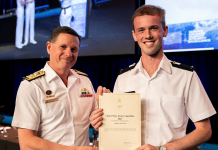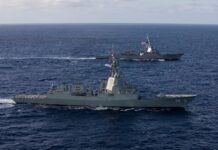ASPI on sea state:
The multinational Rim of the Pacific Exercise concluded this week with an amphibious landing trial. The US was supposed to participate, but was sidelined when two of its biggest warships, USS Bonhomme Richard (LHD-6) and USS Boxer (LHD-4), suffered mechanical failures. In the end, Australia’s HMAS Adelaide practised the amphibious assault almost by itself, assisted by the Filipino navy’s new landing platform dock BRP Davao del Sur. Analysts say that the failure of the warships indicates an ‘amphibious readiness gap’ in the US Navy.
Iran’s Islamic Revolutionary Guards Corps conducted a massive military exercise involving 100 warships in the Strait of Hormuz, a strategic waterway that’s crucial for regional connectivity and trade. The drills were purportedly held to send a message to the US amid heightened tensions following President Donald Trump’s decision to withdraw from the Joint Comprehensive Plan of Action. The Iranian ships are ‘small, fast, deadly, and designed specifically to present an asymmetrical threat to the toughest ships’ and could ‘cripple’ the US Navy through guerrilla tactics.
The recent Iranian war games are reminiscent of the infamous Millennium Challenge 2002 run by the erstwhile US Joint Forces Command. The red team, which was playing the enemy forces, used unexpected tactics and destroyed the blue team’s navy. Unhappy with the result, the blue team resurrected its forces and manipulated the outcome by cheating. The exercise is a case study on how a small, well-organised navy can defeat a much bigger and stronger adversary.
First published by the Australian Strategic Policy Institute


